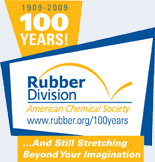![[ Visit ACS Rubber Website ]](images/logo.jpg) |
|
Advances in Trans Polymers for Low Rolling Resistance TiresTuesday, April 27, 2010: 9:00 AM
Akron/Summit Ballroom (Akron/Fairlawn Hilton Hotel)
Trans-Polymers: Potential Partial Replacements for Natural Rubber
One of the many attractive features of Natural Rubber (NR) is its ability to strain crystallize upon stretching. NR’s macro- and micro-structural features give it highly desired properties in both passenger and truck tires formulations. The need for a crystallizable polymer to use as partial replacements for NR has led us to the investigation of trans-PBD and trans-SBR elastomers. The trans-PBD is a highly crystalline polymer that can be made from the readily available butadiene monomer. This polymer has some of the stain crystallization features of NR. Similar to Natural Rubber, Tran’s polymer has the same melting point, which gives them the ability to strain crystallize and have the property of low hysteresis. Tran’s polymer preparation and the resultant elastomeric properties will be discussed in detail in the following discussions, with a major emphasis on the advantages and disadvantages of each catalyst system. |
